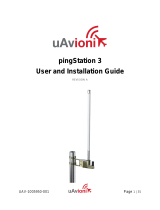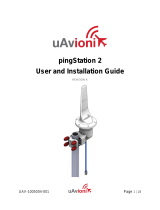Page is loading ...

GE
Intelligent Platforms
Military
Communications

You can have peace of mind that comes from working with a
proven supplier.
GE Intelligent Platforms is a global leader in
the design and manufacture of communi-
cations electronics and subsystems for the
military, telecommunications and industrial
markets. With a strong presence in all three
markets, we leverage a unique portfolio of
products and depth of expertise in delivering
communications solutions for our global
defense, aerospace and security customers.
GE offers a range of military-rugged and
commercial communications solutions
including:
• Routersandswitches
• Packetprocessingsubsystemsforencryp-
tion, compression and traffic shaping
• Cybertoolsforintrusiondetection
and prevention
• Firewalls
• CommunicationsInterfaces
Our research and development operations
help to ensure that your solutions remain at
the leading edge of communications tech-
nology. Whether it is the delivery of raw
bandwidth through 10 and 40 Gig Ethernet,
or the application of MANET protocols
for the airborne networking layer or even
the firewalls used to protect battlefield
networks, we continue to expand what is
possible in communications technologies.
The company is approved to ISO 9001:2000
and AS/EN 9100 for design and manufac-
ture, and is committed to long-term support
of your application. A full Product Lifecycle
Management package that in some cases
has kept programs running for more than
20 years is available for all products.
Enabling and securing the
connected warfighter
MILITARY COMMUNICATIONS

High-performance, secure communications electronics are
at the core of the network-enabled battlefield.
Leading-edge networking
communications solutions
Military operations worldwide
have become increasingly
reliant on the secure communi-
cation of voice, video and data.
Whether it is a UAV transmit-
ting high-definition video for
accurate target tracking or
cloud services delivered over
cellular links to a dismounted
warfighter, advanced commu-
nications technologies can
enable information superiority
and protect a fighting force.
DEFENSE.GE-IP.COM/MIL-COMM
Routing in the Airborne Layer (Air)
Airborne assets such as fighter jets, UAVs,
airships and wide-body aircraft have
become network nodes in a wide-reaching
airborne IP network. These networks are
particularly challenging to deploy and
manage due to their dynamic, sometimes
bandwidth-limitednature.Routerssuch
asGE’sRTR8GEoffermeshnetworking
features and radio-aware routing protocols
to help build the airborne networking layer.
Video Communications
Encryption/Compression (Air)
Streaming video collected by UAVs and
transmitted to forward command centers
canprovidevaluableISRdata.Thecommu-
nications links for this data be encrypted
and compressed. This takes tremendous
processing power. GE’s CPC500 can employ
64 cores as a high-performance crypto and
compression engine in a small, rugged and
low-power package.
Switching Application
Vehicular Networks
Military vehicles are loaded with sensors
and electronics systems. Video and data
streams, target tracking information, vehicle
diagnostics, weapons systems, threat
and chemical detection are just some of
the platforms all connected to a common
Ethernet backbone. GE’s GBX460 rugged
switch provides a robust, manageable 10
GigE interconnect for such applications.
Intrusion Prevention
Firewalls/IA
A network centric battlefield is dynamic
and complex. As these networks grow to
accommodate more sensors and network
nodes, cyber security becomes a major
concern.GE’sRTR8GEruggedbattlefield
router includes a hardware-assisted
stateful firewall and intrusion detection
system to protect against cyber-attack.
The product also features advanced
anti-tamper and information assurance
features to protect data at the halt.

Ruggedbattlefield
networking
Providing secure communications to networked
warfighters
Today’s battlefield, not unlike today’s
commercial business environment, is an
information war zone. As forces seek to gain
a competitive edge through information
dominance, a high-speed, highly available
and secure network becomes critical to
even the basic operations of war. Almost all
modern battlefield assets are connected to a
high-speed IP network with routers, switches
and packet processors at their core.
An insatiable demand for bandwidth is
driving network innovation in delivering
voice, video, and data services in the
commercial world. Military forces are
seeking to leverage these commercial
innovations, but they have additional
requirements and greater challenges to
overcome for battlefield deployments:
RoutingforDynamic
Battlefield Environments
The Internet is based on a static network
configuration. The routers, switches and
network nodes are confined to a datacenter
in a single geographic location and are
usually connected to reliable, high-speed
links. Commercial routers are designed to
operate in this static configuration.
Contrast this to a battlefield network where
network nodes are constantly moving
over dispersed geographic locations, and
network nodes may drop due to enemy
attack or due to unreliable radio links that
suddenly decline in bandwidth. Standard
routing protocols such as the Border
Gateway Protocol (BGP) or open shortest
pathfirst(OSPF)fallshortinsuchbattle-
field networks.
Routersdesignedspecificallyforbattlefield
deployment address the dynamic nature of
the network by implementing specialized
protocolandmanagementfeatures.For
example,GE’sRTR8GEBattlefieldRouter
features radio-aware protocols and quality
of service (QOS) mechanisms that enable
it to monitor and measure radio hop effi-
ciency and effective available bandwidth.
This enables the router to intelligently
direct traffic across the most effective hop
sequence, and when necessary to regulate
traffic flow for QOS.
Cyber Threat Avoidance
andResilience
Any IP-based edge network node is vulner-
able to denial of service attack, unwanted
network access or network sabotage.
Various security-focused tools like firewalls,
network monitoring and intrusion detection
systems are deployed to protect IP networks.
New battlefield routers such as GE’s
RTR8GEhavebeendesignedfromthe
ground up with advanced hardware-
assisted security features:
Firewall
• Bruteforceattackmitigation
• DoSandDDOSprotection
• TCPreassemblyforfragmentedpacket
protection
• Networkattackdetection
• SYNcookieprotection
• Malformedpacketprotection
• Zone-basedIPspoofing
Intrusion Prevention System (IPS)
• Protocolanomalydetection
• Statefulprotocolsignatures
• IPSattackpatternobfuscation
• Customersignaturescreation
• Frequencyofupdates
(daily and emergency)
Information Assurance
and Anti-tamper
Advanced security software and protocols
are designed to protect data as it enters
a network or transfers between network
nodes.Designersofbattlefieldroutersmust
also recognize the potential threat of a foe
physically accessing the router hardware
and accessing critical data stored in it. This
so-called data-at-rest could include infor-
mation about network topology, encryption
schemes, passwords or even snippets of
the network traffic itself. In some instances
an attacker may attempt to insert data, or
malicious code such as a virus or backdoor
access with a Trojan horse.
MILITARY COMMUNICATIONS

TheGERTR8GEbattlefieldrouterincludes
support for memory sanitization through
non-volatilememoryread-only(NVMRO).
This capability ensures that all confidential
information is removed from memory when
therouterisrebooted.NVMROalsophysi-
callylocksNANDsystemstorage,NORboot
flash,andallEEPROMS.
Finally,asanaddedsecuritymeasure,the
internalelectronicsoftheRTR8GEbattle-
field router features physical anti-tamper
mechanisms to alert of an intruder’s
attempt to physically tamper with the
router’s internal electronics.
Ethernet Ubiquity
With the adoption of Network-based
operations, proprietary communica-
tions protocols and equipment have been
replaced by Ethernet and Ethernet switches.
Battlefield system architects require a wide
range of Ethernet switch connectivity options.
Port densities commonly range from one
or two ports to 24 with options for copper
orfiberconnectivity.Datatransportfrom
environmental sensors within a vehicle may
only require 10/100 Ethernet connectivity,
while high-definition video often requires 10
and even 40 GigE connectivity. Some appli-
cations require only simple transport and
static configurations and can therefore be
implemented using a simple, low-cost non-
managed switch. Many others require traffic
management for dynamic network environ-
ments and therefore a switch with advanced
management capabilities is required.
GE offers one of the broadest Ethernet
switch product offerings available on the
military market. Products such as the cost
optimizedNETernityRM981RCofferGigabit
Ethernet connectivity with 12 or 24 ports.
The NETernity GBX460 offers an amazing
20 or 24 ports of 10 GigE with advanced
management capabilities and GE even
offers a switch with up to 15 40 GigE ports
for very bandwidth-hungry applications
Interoperability,Flexibility
and Management
Ethernet everywhere is the stated goal, but
is not necessarily the reality today. There
will always be some sensor or device that
does not connect over Ethernet. In addition,
complications may arise in joint or multi-
national operations where different tactical
battlefield networks must communicate.
Military network assets must be flexible and
or customizable to provide connectivity
in such complex environments where
network management becomes a
major challenge.
GE introduced the OpenWare flexible
network protocol and management suite
to address these challenges. OpenWare
is GNU/Linux-based firmware that brings
together the best of Open Source and
proprietary switch control, routing and
protocol implementations. The flexible
OpenWare environment allows customiza-
tion for specific requirements. Because
OpenWare is completely designed and
owned by GE, we can customize it to meet
specific customer requirements.
DEFENSE.GE-IP.COM/MIL-COMM

MILITARY COMMUNICATIONS
fire control computer
mission computer
driver display
vehicle diagnostics
voip processor
voip processor
360 situational awareness cams
commander display
satcom station
data radio
win-t isr radio
active protection system
dvr
turret display
sensor array
Redefiningbattlefield
vetronics

Product Type
Common
Use Cases
Networking Security Management
Example
Application
Battlefield Network Gateway
Multi-Network,
DynamicNetwork
Infrastructure,
RemoteManage-
ment, WAN
interface,Firewall,
IPS/IDS,Classi-
fied/Unclassified
traffic, High port
density, advanced
encryption
NAT,Radio-aware
routing(RFC4938,
Credit Based
RadioRouter
Protocol exten-
sions to PPPoE,
R2P),VLAN,
Advanced QOS,
Link Aggrega-
tion, Mirroring,
Port Config,
RateLimiting,
Multicast, MSTP,
VRRP,FOG,RIP,
OSPF,BGP,IPv6
Tunneling,Diff-
Serv
AdvancedDoS,
DDoS,Frag-
mented Packet,
BruteForce,SYN
cookie,Zone-
based IP spoofing,
Malformed
Packet, Protocol
Anomoly detec-
tion, stateful
protocol signa-
tures, IPS attack
pattern obfusca-
tion, Customer
signatures,
CCEAL4,FIPS
140-2 L2, HAIPE
DHCP(Client,
Server,Relay),
SNMP, Config
Profiles, Out of
band, In-band,
CLI (Telnet, SSH,
Console), Web
Interface, API,
SOA
Ground Vehicle
Networks
(VICTORY)w.
ReachForward/
Back WAN
Battlefield Router/Firewall
Multi-Network,
DynamicNetwork
Infrastructure,
RemoteManage-
ment, WAN
interface,Firewall,
IPS/IDS,Classi-
fied/Unclassified
traffic
NAT,Radio-aware
routing(RFC4938,
Credit Based
RadioRouter
Protocol exten-
sions to PPPoE,
R2P),VLAN,
Advanced QOS,
Link Aggrega-
tion, Mirroring,
Port Config,
RateLimiting,
Multicast, MSTP,
VRRP,FOG,RIP,
OSPF,BGP,IPv6
Tunneling,Diff-
Serv
AdvancedDoS,
DDoS,Frag-
mented Packet,
BruteForce,SYN
cookie,Zone-
based IP spoofing,
Malformed
Packet, Protocol
Anomoly detec-
tion, stateful
protocol signa-
tures, IPS attack
pattern obfusca-
tion, Customer
signatures,
CCEAL4,FIPS
140-2 L2
DHCP(Client,
Server,Relay),
SNMP, Config
Profiles, Out of
band, In-band,
CLI (Telnet, SSH,
Console), Web
Interface, API,
SOA
Airborne Network
Layer, UAV w.
Reachforward/
back WAN,
Ground Vehicle
Networks, Mobile
communications
Fully Managed
Layer 2/3 Switch
Multi-LAN,
DynamicNetwork
Infrastructure,
RemoteManage-
ment,Layer2/3
switching and
routing
VLAN, QOS,
Link Aggrega-
tion, Mirroring,
Port Config,
RateLimiting,
Multicast, MSTP,
VRRP,FOG,RIP,
OSPF,BGP,IPv6
Tunneling,Diff-
Serv
Storm Control,
Filtering,Basic
DoSprotection,
DHCPSnooping,
MAC Notification,
Port Security/
Authorization
DHCP(Client,
Server,Relay),
SNMP, Config
Profiles, Out of
band, In-band,
CLI (Telnet, SSH,
Console), Web
Interface
Vehicular System
or Shipboard
RadarDisplay
Networking,
Unmanaged Switch
Single LAN,
Simple data,
Static Network
Config, high port
density, latency-
sensitive traffic
Layer 2 switching N/A N/A System Back-
planes, High
Speed Sensor
interconnects
Networked Sensor Processor
Single LAN, Video
over Ethernet
Sensor Network
XAUIFullDuplex
Ethernet ports, 4
Lane PCI Express
ports, GigE vision
support GVCP,
GVSP
Hardware
assisted Encryp-
tion engines
Programmable
user interface,
standard LINUX
OS, Complete
GigE vision
camaera
management
UAVISRVideo
Processing
Network
Packet Processor/
Traffic Shaper
Multi-network,
bandwidth
constrained
environments,
Classified/Unclas-
sified traffic, Video
Sensor Traffic
High-speed
10gbps links,
optimized to
transport video
streams, Hard-
ware assisted
compression
Hardware
assisted Encryp-
tion engines
Programmable
user interface,
standard LINUX
OS, Complete
GigE vision
camaera
management
Airborne Perfor-
mance Enhancing
Proxies (PEP)
DEFENSE.GE-IP.COM/MIL-COMM

11.11GFA-1848
GE Intelligent Platforms Contact Information
Americas: 1 800 433 2682 or 1 434 978 5100
Global regional phone numbers are listed by location on our web site at www.ge-ip.com/contact
defense.ge-ip.com/mil-comm
©2011 GE Intelligent Platforms, Inc. All rights reserved.
All other brands or names are property of their respective holders.
/




